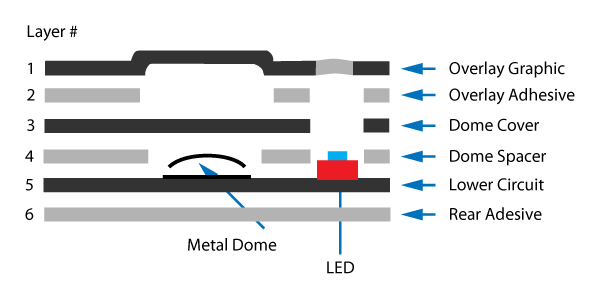Membrane switch in digital appliances: user experience considerations
All Concerning Membrane layer Switch: A Comprehensive Guide for Beginners
Membrane switches are crucial parts in modern electronic devices, using an one-of-a-kind interface for user interaction - membrane switch. Their layered construction, consisting of overlays and conductive traces, supplies functionality and toughness. Unlike conventional mechanical buttons, membrane switches provide a smooth style and customizable alternatives. Recognizing their vital functions and advantages can transform item style. Nonetheless, the complexities of their application and design considerations warrant additional expedition
What Is a Membrane layer Change?
A membrane button is a sort of electric button that includes a flexible membrane layer layered over a printed circuit card. This style permits for a small and streamlined user interface, typically made use of in various electronic gadgets. Membrane layer buttons are generally found in consumer home appliances, medical devices, and commercial equipment as a result of their resilience and resistance to environmental factors.The building usually consists of numerous layers, such as visuals overlays and glue support, which offer responsive responses and protect the circuitry underneath. The procedure of a membrane layer button is started when stress is applied to the surface, completing an electric circuit.These switches are valued for their flexibility, allowing custom-made styles and printed graphics that deal with particular interface. Their low-profile nature decreases space needs, making them suitable for applications where standard buttons may not fit. In general, membrane layer buttons use a practical and aesthetic remedy for modern-day electronic devices.
Key Elements of Membrane Layer Changes
Membrane switches over consist of a number of essential components that add to their performance and performance. The leading layer, called the overlay, supplies the individual interface and is typically printed with icons or graphics. Underneath the overlay lies a spacer layer, which divides the conductive aspects and avoids inadvertent activation. The following important part is the visuals layer, which enhances visual appeals and guarantees the durability of the design.Conductive traces, commonly made from materials like silver or carbon, are published on the circuit layer. When stress is related to the overlay, these traces come right into contact, finishing the circuit. Additionally, a support layer provides architectural support and can be made from products such as polyester or polycarbonate. With each other, these elements produce a reputable, easy to use interface ideal for different applications, from household home appliances to commercial devices. Recognizing these elements is crucial for anybody curious about membrane switch modern technology.
How Membrane Changes Job
Understanding exactly how membrane layer switches function is necessary for valuing their prevalent use in various gadgets. A membrane layer button operates with a collection of layers, consisting of a visuals overlay, spacer, and a circuit layer. When pressure is put on the overlay, it compresses the spacer layer, permitting the circuit layer to make call and complete an electrical circuit. This action sends a signal to the gadget, motivating a response, such as activating a light or triggering a function.Membrane changes can be created with numerous features, including tactile feedback, backlighting, and customized graphics, improving individual communication. Their building and construction permits for a covered layout, protecting the internal components from dust, moisture, and contaminants. This sturdiness makes them appropriate for diverse applications, from consumer electronics to industrial equipment. Overall, the simplicity and performance of membrane changes contribute to their popularity in modern-day technology.
Benefits of Membrane Layer Changes Over Mechanical Switches
While mechanical switches have long been a staple in numerous devices, membrane switches deal unique advantages that make them progressively appealing. One significant benefit is their slim account, permitting more compact layouts and better versatility in item advancement. Additionally, membrane switches over function an uniform surface area, which boosts aesthetic appeal and streamlines cleansing, making them suitable for settings where health is critical.Another advantage is their resistance to dust and dampness. Unlike mechanical switches, which can be compromised by ecological aspects, membrane buttons supply a closed user interface that secures against impurities - membrane switch. In addition, membrane buttons normally have a longer life expectancy due to less moving components, resulting in boosted sturdiness and reliability.Cost-effectiveness is also a remarkable benefit, as membrane layer switches can be generated wholesale with reduced manufacturing prices. These variables combine to place membrane layer switches as a functional alternative to standard mechanical alternatives in various applications
Typical Applications of Membrane Layer Switches
Membrane buttons are extensively used in different fields, specifically in consumer electronics and commercial control board. In customer devices, they offer a streamlined, user-friendly interface, while in industrial setups, they boost durability and performance. Comprehending these applications highlights the convenience and practicality of membrane switches in modern technology.
Consumer Electronics Gadgets
As customer electronic devices proceed to advance, membrane layer buttons have actually become a popular choice for a variety of gadgets because of their flexibility and smooth style. These buttons are frequently discovered in smart devices, tablet computers, and push-button controls, where area is restricted and aesthetics issue. Their reduced account and adjustable designs allow producers to produce easy to use interfaces that enhance the overall user experience. In addition, membrane layer buttons are commonly utilized in home appliances such as microwaves and coffee machine, providing intuitive control alternatives while standing up to wetness and dirt. The durability and integrity of membrane layer changes make them suitable for day-to-day customer products, making certain long life and constant efficiency. On the whole, their integration in consumer electronic devices reflects a mix of performance and modern layout.
Industrial Control Panels
The applications of membrane switches expand beyond customer electronic devices, finding substantial use in commercial control panels. These buttons are favored for their durability and resistance to rough atmospheres, making them perfect for making and process control setups. They provide a reliable user interface for drivers to manage equipment, screen procedures, and adjust setups. Membrane layer switches can be tailored to suit certain operational requirements, including functions like backlighting and responsive feedback, improving customer experience. Their low-profile style permits Homepage integration right into various tools, while their capability to hold up against spills, dust, and extreme temperature levels guarantees durability. On the whole, membrane layer switches add to safe and effective procedure in commercial applications, demonstrating their flexibility and performance popular environments.
Considerations for Creating Membrane Layer Switches Over
When designing membrane switches, choosing the ideal products is important to ensure toughness and capability. Additionally, understanding layer setup methods can considerably influence the button's efficiency and customer experience. These factors to consider play a vital duty in developing dependable and effective membrane switch layouts.
Product Option Relevance
Product choice plays a crucial duty in the layout and performance of membrane switches. The chosen products straight impact the switch's sturdiness, tactile reaction, and overall visual. Trick factors to consider include the substrate, which have to give architectural stability while enabling flexibility, and the visuals overlay, which requires to be resistant to wear and environmental variables. Conductive products must ensure reputable electrical efficiency, while adhesives have to use strong bonding without compromising the button's operation. Additionally, compatibility with making processes and end-user environments is essential; materials must hold up against varying temperatures, moisture levels, and chemical direct exposure. Eventually, proper material option not only boosts the membrane button's performance yet likewise contributes to its durability and user contentment, making it an important aspect of the layout process.

Layer Arrangement Techniques

Often Asked Questions
For How Long Do Membrane Switches Over Usually Last?
Membrane layer switches normally have a lifespan of 1 to 5 million cycles, depending upon use and ecological conditions. Aspects such as design high quality and operating regularity greatly influence their longevity and overall performance long life.

Can Membrane Switches Be Custom-made for Particular Styles?
Membrane buttons can without a doubt be tailored to suit certain designs, allowing for varied shapes, colors, and capabilities. This convenience allows producers to tailor these buttons to meet unique visual and operational needs successfully.
What Materials Are Made Use Of in Membrane Switch Over Building?
Membrane layer buttons are Visit This Link commonly created making use of products such as polyester, polycarbonate, and glue layers. These products give flexibility, toughness, and resistance to environmental elements, making sure the buttons function successfully in numerous applications and problems.
Are Membrane Switches Water Resistant or Resistant to Moisture?
Membrane switches can be developed to be moisture-resistant, using specialized materials and coverings. Nevertheless, their water resistant capacities rely on building and construction quality and specific applications, making it important to examine needs for excellent efficiency in numerous settings.
Exactly How Are Membrane Switches Repaired if Harmed?
Repairing broken membrane changes usually entails changing the influenced layer or circuit. Technicians may also use conductive glue or utilize specialized repair service sets, ensuring functionality is recovered without total replacement of the whole button assembly. Unlike standard mechanical switches, membrane layer buttons provide a sleek layout and adjustable options. A membrane layer switch is a type of electric switch that is composed of a versatile membrane layer layered over a published circuit board. The operation of a membrane layer switch try this is launched when pressure is used to the surface, finishing an electric circuit.These switches are valued for their adaptability, allowing personalized styles and printed graphics that cater to specific individual interfaces. While mechanical switches have long been a staple in several gadgets, membrane layer changes deal unique benefits that make them progressively appealing. Membrane layer switches typically have a longer life-span due to fewer relocating components, resulting in improved durability and reliability.Cost-effectiveness is likewise a notable benefit, as membrane layer switches can be created in mass with lower manufacturing prices.